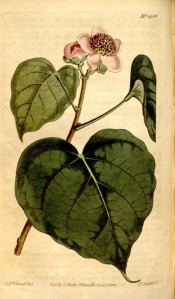Bixa orellana L.
Frost tender, intricately branched, evergreen tree with ovate-heart-shaped leaves and terminal panicles of 3-5, open cup-shaped, 5-petalled, purple-tinted, white or pink flowers in summer and autumn, followed by bristly bright red or dark pink fruit, full of dark red seeds. To 10m by 5m. [RHSE, Hortus].
Horticultural & Botanical History
‘A handsome stove shrub from its fine green foliage, though it very rarely produces any flowers in this country: Miller remarks that he had several of these plants seven or eight feet high, with strong stems and large heads, but that only one produced flowers, nor had he heard of its flowering in any of the gardens in Europe. Native of South-America, the West and East-Indies; at least it is cultivated in these parts of the world, chiefly for the sake of the colour extracted from the seeds, and which is known here by the name of Anotta, or cheese-colouring, being the drug commonly used in Gloucestershire to give a deeper colour to their cheese. It is said too to be added to their butter for the same purpose, by the Dutch dairy women. The Indians paint the whole of their bodies with this colour; and it is sometimes used as a rouge by European females. The South-American Spaniards make great use of it as an ingredient in their chocolate and soups, not only for the sake of its colour, but on account of its supposed cordial virtues [i.e. invigorating the heart].’ [BM t.1456/1812]. Introduced to Britain in 1690. [JD].
History at Camden Park
Probably short lived in the gardens as it is only listed in the 1850 catalogue. Macarthur may have introduced it to test its potential as a source of red Annatto dye.
Notes
Published Feb 27, 2009 - 04:25 PM | Last updated Jul 15, 2010 - 02:02 PM
| Family | Bixaceae |
|---|---|
| Category | |
| Region of origin | Tropical America, West Africa |
| Synonyms | |
| Common Name | Achiote, Annatto tree, Lipstick tree |
| Name in the Camden Park Record | Bixa orellana |
| Confidence level | high |


